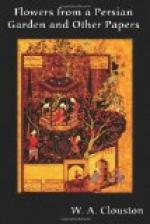[44] Many Asiatic stories relate
to the concealing of
treasure—generally
at the foot of a tree, to mark the
spot—by
two or more companions, and its being secretly
stolen
by one of them. The device of the carpenter in
the
foregoing tale of abducting the rascally goldsmith’s
two
sons, and so on, finds an analogue in the
Panchatantra,
the celebrated Sanskrit collection of
fables
(Book I, Fab. 21, of Benfey’s German
translation),
where we read that a young man, who had
spent
the wealth left to him by his father, had only a
heavy
iron balance remaining of all his possessions, and
depositing
it with a merchant went to another country.
When
he returned, after some time, he went to the
merchant
and demanded back his balance. The merchant
told
him it had been eaten by rats; adding: “The
iron of
which
it was composed was particularly sweet, and so the
rats
ate it.” The young man, knowing that the
merchant
spoke
falsely, formed a plan for the recovery of his
balance.
One day he took the merchant’s young son,
unknown
to his father, to bathe, and left him in the
care
of a friend. When the merchant missed his son
he
accused
the young man of having stolen him, and summoned
him
to appear in the king’s judgment-hall. In
answer to
the
merchant’s accusation, the young man asserted
that a
kite
had carried away the boy; and when the officers of
the
court declared this to be impossible, he said:
“In a
country
where an iron balance was eaten by rats, a kite
might
well carry off an elephant, much more a boy.”
The
merchant,
having lost his cause, returned the balance to
the
young man and received back his boy.
The Sixth Tale of the Parrot, according to the India Office MS., relates to
The Woman Carved out of Wood.
Four men—a goldsmith, a carpenter, a tailor, and a dervish—travelling together, one night halted in a desert place, and it was agreed they should watch turn about until daybreak. The carpenter takes the first watch, and to amuse himself he carves the figure of a woman out of a log of wood. When it came to the goldsmith’s turn to watch, finding the beautiful female figure, he resolved also to exhibit his art, and accordingly made a set of ornaments of gold and silver, which he placed on the neck, arms, and ankles. During the third watch the tailor made a suit of clothes becoming a bride, and put them on the figure. Lastly, the dervish, when it came to his turn to watch, beholding the captivating female form, prayed that it might be endowed with life, and immediately the effigy became animated. In the morning all four fell in love with the charming damsel,




